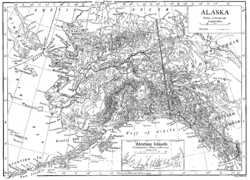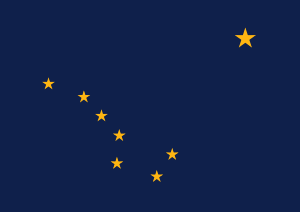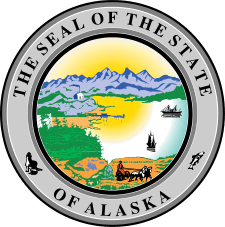Territory of Alaska
| Territory of Alaska | |||||
| Organized incorporated territory of the United States | |||||
| |||||
|
Flag | |||||
 | |||||
| Capital | Juneau | ||||
| Government | Organized incorporated territory | ||||
| Governor | |||||
| • | 1912–1913 | Walter E. Clark | |||
| • | 1958–1959 | Waino E. Hendrickson | |||
| History | |||||
| • | District of Alaska | August 24, 1912 | |||
| • | Statehood | January 3, 1959 | |||
 |
| History of Alaska |
|---|
| Prehistory |
| Russian America (1733–1867) |
| Department of Alaska (1867–1884) |
| District of Alaska (1884–1912) |
| Territory of Alaska (1912–1959) |
| State of Alaska (1959–present) |
| Other topics |
The Territory of Alaska or Alaska Territory was an organized incorporated territory of the United States that existed from August 24, 1912, until January 3, 1959, when it was admitted to the Union as the State of Alaska. The territory was created as the District of Alaska on May 17, 1884.
Origin
The passing of the 1899 Criminal Code, which among other things included a tax on liquor, led to increased calls for Alaskan representation in Congress,[1] and the debate finally ended on August 24, 1912, when the Alaska Territory became an organized, incorporated territory of the United States.
The Second Organic Act of 1912, renamed the District of Alaska as the Territory of Alaska.[2] By 1916, its population was about 58,000. James Wickersham, a Delegate to Congress, introduced Alaska's first statehood bill, but it failed due to lack of interest from Alaskans. Even President Warren G. Harding's visit in 1923 could not create widespread interest in statehood. Under the conditions of the Second Organic Act, Alaska had been split into four divisions. The most populous of the divisions, whose capital was Juneau, wondered if it could become a separate state from the other three. Government control was a primary concern, with the territory having 52 federal agencies governing it.
Middle 20th century
In 1920, the passage of the Jones Act required U.S.-flagged vessels to be built in the United States, owned by U.S. citizens, and documented under the laws of the United States. All goods entering or leaving Alaska had to be transported by American carriers and shipped to Seattle prior to further shipment, making Alaska dependent on the state of Washington. The U.S. Supreme Court ruled that the provision of the Constitution saying one state should not hold sway over another's commerce did not apply because Alaska was only a territory. The prices Seattle's shipping businesses charged began to rise to take advantage of the situation.
The Great Depression caused prices of fish and copper, which were vital to Alaska's economy at the time, to decline. Wages were dropped and the workforce decreased by more than half. In 1935, President Franklin D. Roosevelt thought Americans from agricultural areas could be transferred to Alaska's Matanuska-Susitna Valley for a fresh chance at agricultural self-sustainment. Colonists were largely from northern states, such as Michigan, Wisconsin, and Minnesota under the belief that only those who grew up with climates similar to that of Alaska's could handle settler life there. The United Congo Improvement Association asked the president to settle 400 African-American farmers in Alaska, saying that the territory would offer full political rights, but racial prejudice and the belief that only those from northern states would make suitable colonists caused the proposal to fail.
The exploration and settlement of Alaska would not have been possible without the development of aircraft, which allowed for the influx of settlers into the state's interior, and rapid transportation of people and supplies throughout. However, due to the unfavorable weather conditions of the state, and high ratio of pilots to population, over 1700 aircraft wreck sites are scattered throughout its domain. Numerous wrecks also trace their origins to the military build-up of the state during both World War II and the Cold War.
Alaska's strategic importance to the United States became more apparent during World War II. From June 1942 until August 1943 the Japanese tried to invade the U.S. by way of the Aleutian island chain, in the Battle of the Aleutian Islands. This marked the first time since the War of 1812 that American soil was occupied by a foreign enemy. The Japanese were eventually repelled from the Aleutian Islands by a force of 34,000 American troops.[3] In the spring and summer of 1945, Cold Bay on the Alaska Peninsula was the site of the largest and most ambitious transfer program of World War II, Project Hula, in which the United States transferred 149 ships and craft to the Soviet Union and trained 12,000 Soviet personnel in their operation in anticipation of the Soviet Union entering the war against Japan. At any given time, about 1,500 American personnel were at Cold Bay and Fort Randall during Project Hula.[4]
Statehood
On January 3, 1959, Alaska became the 49th state. There was some delay because of concern by members of the national Republican Party that Alaska would elect Democratic Party members to Congress, in contrast to Hawaii, which was also a contender for statehood at the same time and thought to have Republican Party support.[5] In recent years these predictions have turned out to be just the opposite for both states.
See also
- Alaska Territory's at-large congressional district
- Historic regions of the United States
- History of Alaska
- Territorial evolution of the United States
- Territory of Russia that encompassed land that later became part of the Territory of Alaska:
- Russian America 1733–1867
- U.S. territories that later became the Alaska Territory:
- Department of Alaska 1867–1884
- District of Alaska 1884–1912
- U.S. state created from Alaska Territory:
- State of Alaska, 1959
- Territory of Russia that encompassed land that later became part of the Territory of Alaska:
Footnotes
- ↑ Nichols, Jeannette Paddock. Alaska, (New York: Russell & Russell INC, 1963), p165.
- ↑ Gislason, Eric. "The 49th State: A Brief History of Alaska Statehood (1867–1959)". American Studies at the University of Virginia. Retrieved 2005-08-31.
- ↑ C.V. Glines, "America's War in the Aleutians," Aviation History, Vol.12(November 2001), 46–51.
- ↑ Russell, Richard A., Project Hula: Secret Soviet-American Cooperation in the War Against Japan, Washington, D.C.: Naval Historical Center, 1997, ISBN 0-945274-35-1, pp. 1, 16, 35.
- ↑ Alaska History and Cultural Studies - Governing Alaska - Campaign for Statehood
Further reading
- Catherine Holder Spude, Saloons, Prostitutes, and Temperance in Alaska Territory. Norman, OK: University of Oklahoma Press, 2015.
Coordinates: 64°N 153°W / 64°N 153°W
